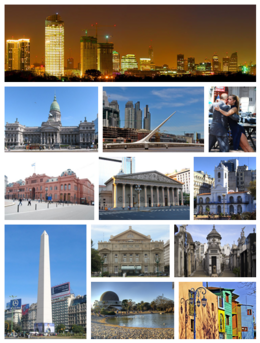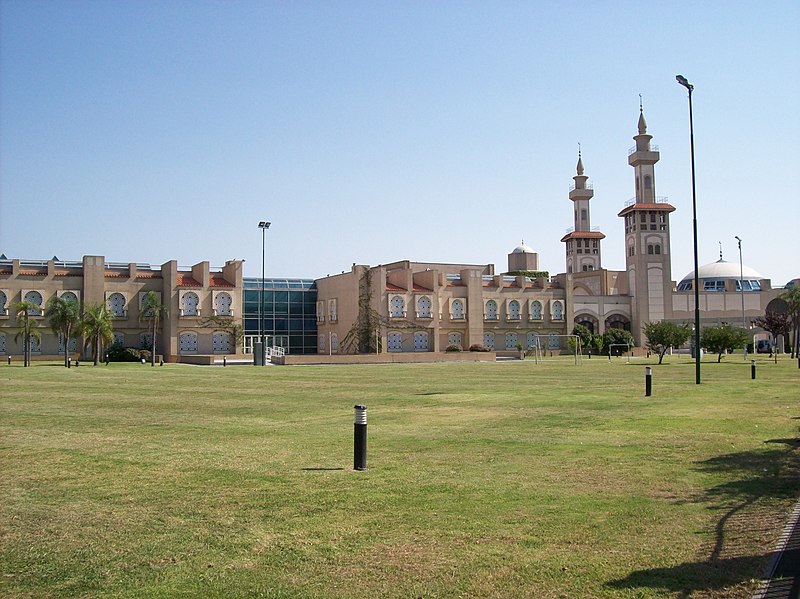 Buenos Aires ( /ˈbweɪnəs ˈɛəriːz/ or /ˈaɪrɪs/,[5] Spanish: [ˈbwenos ˈaiɾes]) is the capital and largest city of Argentina, and the second-largest metropolitan area in South America, after São Paulo.[6] It is located on the western shore of the estuary of the Río de la Plata, on the southeastern coast of the South American continent. Greater Buenos Aires conurbation, which also includes several Buenos Aires Province districts, constitutes the third-largest conurbation in Latin America, with a population of around thirteen million.
Buenos Aires ( /ˈbweɪnəs ˈɛəriːz/ or /ˈaɪrɪs/,[5] Spanish: [ˈbwenos ˈaiɾes]) is the capital and largest city of Argentina, and the second-largest metropolitan area in South America, after São Paulo.[6] It is located on the western shore of the estuary of the Río de la Plata, on the southeastern coast of the South American continent. Greater Buenos Aires conurbation, which also includes several Buenos Aires Province districts, constitutes the third-largest conurbation in Latin America, with a population of around thirteen million.The city of Buenos Aires is not a part of Buenos Aires Province, nor is it the Province's capital, but an autonomous district. In 1880, after decades of political infighting, Buenos Aires was federalised and removed from Buenos Aires Province. The city limits were enlarged to include the towns of Belgrano and Flores (both are currently neighborhoods of the city). The 1994 constitutional amendment granted the city autonomy, hence its formal name: Ciudad Autónoma de Buenos Aires (Autonomous City of Buenos Aires). Its citizens first elected a Chief of Government (i.e. Mayor) in 1996; before, the Mayor was directly appointed by the President of the Republic.

Buenos Aires is considered an Alpha World City as listed by the Loughborough University group's (GaWC) 2008 inventory.People from Buenos Aires are referred to as porteños (people of the port). Buenos Aires is a top tourist destination, and is known for its European style architecture and rich cultural life.
Colonial
From its earliest days, Buenos Aires depended primarily on trade. During most of the 17th and 18th centuries, Spanish ships were menaced by pirates, so they developed a complex system where ships with military protection were dispatched to Central America, cross the land, from there to Lima, Peru and from it to the inner cities of the viceroyalty. Because of this, products took a very long time to arrive in Buenos Aires, and the taxes generated by the transport made them prohibitive. This scheme frustrated the traders of Buenos Aires, and a thriving contraband industry developed. This also instilled a deep resentment in porteños towards the Spanish authorities

Sensing these feelings, Charles III of Spain progressively eased the trade restrictions and finally declared Buenos Aires an open port in the late 18th century. The capture of Porto Bello by British forces also fueled the need to foster commerce via the Atlantic route, to the detriment of Lima-based trade. One of his rulings was to split a region from the Viceroyalty of Perú and create instead the Viceroyalty of the Río de la Plata, with Buenos Aires as the capital. However, Charles's placating actions did not have the desired effect, and the porteños, some of them versed in the ideology of the French Revolution, became even more convinced of the need for Independence from Spain.

The May Revolution was a turning point in the politics of Buenos Aires.
During the British invasions of the Río de la Plata, British forces attacked Buenos Aires twice. In 1806 the British successfully invaded Buenos Aires, but an army from Montevideo led by Santiago de Liniers defeated them. In the brief period of British rule, the viceroy Rafael Sobremonte managed to escape to Córdoba and designated this city as capital. Buenos Aires became again the capital after its liberation,  but Sobremonte could not resume as viceroy. Santiago de Liniers, chosen as new viceroy, armed the city to be prepared against a possible new British attack, defeating the invasion attempt of 1807. The militarization generated in society changed the balance of power favorably for the criollo peoples, as well as the development of the Peninsular War in Spain. An attempt by the peninsular merchant Martín de Álzaga to remove Liniers and replace him with a Junta was defeated by the criollo armies.
but Sobremonte could not resume as viceroy. Santiago de Liniers, chosen as new viceroy, armed the city to be prepared against a possible new British attack, defeating the invasion attempt of 1807. The militarization generated in society changed the balance of power favorably for the criollo peoples, as well as the development of the Peninsular War in Spain. An attempt by the peninsular merchant Martín de Álzaga to remove Liniers and replace him with a Junta was defeated by the criollo armies.  However, by 1810 it would be those same armies who would support a new revolutionary attempt, successfully removing the new viceroy Baltasar Hidalgo de Cisneros. This is known as the May Revolution, which is in present day celebrated as a national holiday. This event started the Argentine War of Independence, and many armies left Buenos Aires to fight the diverse strongholds of royalist resistance, with varying levels of success. The government was held first by two Juntas of many members, then by two triumvirates of only three members, and finally by an unipersonal office, the Supreme Director. Formal independence from Spain was declared in 1816, in the Congress of Tucumán. Buenos Aires managed to endure the whole Spanish American wars of independence without falling again into royalist rule.
However, by 1810 it would be those same armies who would support a new revolutionary attempt, successfully removing the new viceroy Baltasar Hidalgo de Cisneros. This is known as the May Revolution, which is in present day celebrated as a national holiday. This event started the Argentine War of Independence, and many armies left Buenos Aires to fight the diverse strongholds of royalist resistance, with varying levels of success. The government was held first by two Juntas of many members, then by two triumvirates of only three members, and finally by an unipersonal office, the Supreme Director. Formal independence from Spain was declared in 1816, in the Congress of Tucumán. Buenos Aires managed to endure the whole Spanish American wars of independence without falling again into royalist rule.
 but Sobremonte could not resume as viceroy. Santiago de Liniers, chosen as new viceroy, armed the city to be prepared against a possible new British attack, defeating the invasion attempt of 1807. The militarization generated in society changed the balance of power favorably for the criollo peoples, as well as the development of the Peninsular War in Spain. An attempt by the peninsular merchant Martín de Álzaga to remove Liniers and replace him with a Junta was defeated by the criollo armies.
but Sobremonte could not resume as viceroy. Santiago de Liniers, chosen as new viceroy, armed the city to be prepared against a possible new British attack, defeating the invasion attempt of 1807. The militarization generated in society changed the balance of power favorably for the criollo peoples, as well as the development of the Peninsular War in Spain. An attempt by the peninsular merchant Martín de Álzaga to remove Liniers and replace him with a Junta was defeated by the criollo armies.  However, by 1810 it would be those same armies who would support a new revolutionary attempt, successfully removing the new viceroy Baltasar Hidalgo de Cisneros. This is known as the May Revolution, which is in present day celebrated as a national holiday. This event started the Argentine War of Independence, and many armies left Buenos Aires to fight the diverse strongholds of royalist resistance, with varying levels of success. The government was held first by two Juntas of many members, then by two triumvirates of only three members, and finally by an unipersonal office, the Supreme Director. Formal independence from Spain was declared in 1816, in the Congress of Tucumán. Buenos Aires managed to endure the whole Spanish American wars of independence without falling again into royalist rule.
However, by 1810 it would be those same armies who would support a new revolutionary attempt, successfully removing the new viceroy Baltasar Hidalgo de Cisneros. This is known as the May Revolution, which is in present day celebrated as a national holiday. This event started the Argentine War of Independence, and many armies left Buenos Aires to fight the diverse strongholds of royalist resistance, with varying levels of success. The government was held first by two Juntas of many members, then by two triumvirates of only three members, and finally by an unipersonal office, the Supreme Director. Formal independence from Spain was declared in 1816, in the Congress of Tucumán. Buenos Aires managed to endure the whole Spanish American wars of independence without falling again into royalist rule.
Historically, Buenos Aires has been Argentina's main venue for liberal and free-trade ideas, while many of the provinces, especially to the northwest, advocated a more conservative Catholic approach to political and social issues. Much of the internal tension in Argentina's history,  starting with the centralist-federalist conflicts of the 19th century, can be traced back to these contrasting views. In the months immediately following the 25 May Revolution, Buenos Aires sent a number of military envoys to the provinces with the intention of obtaining their approval. Many of these missions ended in violent clashes, and the enterprise fueled the tensions between the capital and the provinces.
starting with the centralist-federalist conflicts of the 19th century, can be traced back to these contrasting views. In the months immediately following the 25 May Revolution, Buenos Aires sent a number of military envoys to the provinces with the intention of obtaining their approval. Many of these missions ended in violent clashes, and the enterprise fueled the tensions between the capital and the provinces.
 starting with the centralist-federalist conflicts of the 19th century, can be traced back to these contrasting views. In the months immediately following the 25 May Revolution, Buenos Aires sent a number of military envoys to the provinces with the intention of obtaining their approval. Many of these missions ended in violent clashes, and the enterprise fueled the tensions between the capital and the provinces.
starting with the centralist-federalist conflicts of the 19th century, can be traced back to these contrasting views. In the months immediately following the 25 May Revolution, Buenos Aires sent a number of military envoys to the provinces with the intention of obtaining their approval. Many of these missions ended in violent clashes, and the enterprise fueled the tensions between the capital and the provinces.
In the 19th century the city was blockaded twice by naval forces: by the French from 1838 to 1840, and later by a joint Anglo-French expedition from 1845 to 1848. Both blockades failed to force the city into submission, and the foreign powers eventually desisted from their demands.
No comments:
Post a Comment